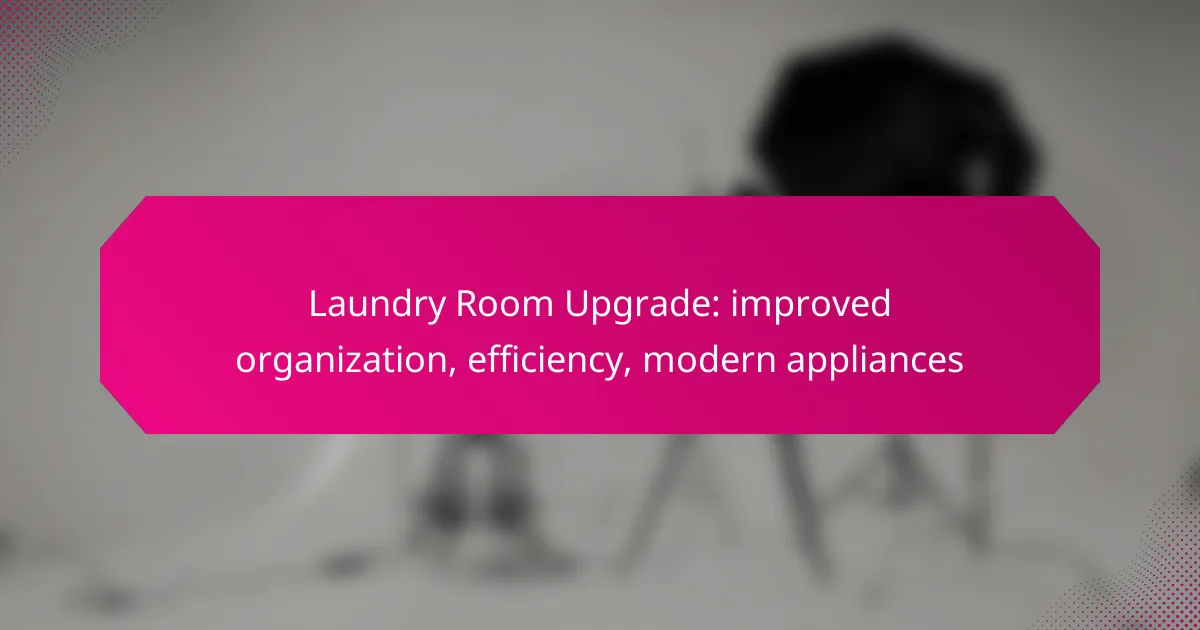Upgrading your laundry room can transform it into a highly organized and efficient space, tailored to meet the demands of modern living. By incorporating smart storage solutions and state-of-the-art appliances, you can enhance functionality while reducing energy consumption. Embrace the latest innovations to streamline your laundry process and create a visually appealing environment that supports your busy lifestyle.

How can I improve laundry room organization in London?
Improving laundry room organization in London involves maximizing space and efficiency through smart storage solutions and modern appliances. By implementing effective strategies, you can create a functional and visually appealing laundry area.
Utilize vertical storage solutions
Vertical storage solutions are essential for optimizing limited space in a laundry room. Consider installing tall cabinets or wall-mounted shelves to keep items off the floor and within easy reach. This approach not only frees up floor space but also helps maintain a tidy appearance.
Use hooks or wall racks to hang frequently used items like ironing boards or brooms. This keeps them accessible while minimizing clutter. Aim for a mix of open and closed storage to balance visibility and organization.
Incorporate labeled bins and baskets
Labeled bins and baskets are effective for categorizing laundry supplies and keeping everything organized. Use clear containers for detergents, fabric softeners, and dryer sheets to quickly identify contents. Labeling helps everyone in the household know where items belong.
Consider using different colors or sizes for various categories, such as whites, colors, and delicates. This not only streamlines the laundry process but also makes it easier to sort clothes before washing.
Install shelving units
Shelving units provide additional storage space for laundry essentials and can be customized to fit your room’s layout. Choose adjustable shelves to accommodate items of varying heights, from tall detergent bottles to smaller fabric care products.
Position shelves above the washer and dryer or in corners to maximize space. Ensure that heavier items are stored on lower shelves for safety and ease of access. Regularly declutter your shelves to maintain organization.
Use a pegboard for tools
A pegboard is a versatile solution for organizing tools and accessories in your laundry room. Install a pegboard on an empty wall to hang items like scissors, measuring cups, and stain removers. This keeps tools visible and easily accessible.
Customize your pegboard with hooks and shelves to fit your specific needs. Consider adding small baskets for smaller items to prevent them from falling off. This system can help you quickly find what you need, enhancing overall efficiency.

What modern appliances enhance laundry efficiency?
Modern appliances such as energy-efficient washing machines, smart dryers, and washer-dryer combos significantly improve laundry efficiency by saving time, reducing energy consumption, and optimizing space. These innovations cater to the needs of busy households looking for effective solutions.
Energy-efficient washing machines
Energy-efficient washing machines use advanced technology to minimize water and electricity usage while maintaining cleaning performance. Look for models that meet Energy Star standards, which can reduce energy consumption by about 20-30% compared to traditional machines.
When selecting an energy-efficient washer, consider features like load sensing, which adjusts water levels based on the size of the load, and high spin speeds that extract more water, reducing drying time. This not only saves energy but also lowers utility bills over time.
Smart dryers with app connectivity
Smart dryers equipped with app connectivity allow users to monitor and control drying cycles remotely via smartphones. This feature enhances convenience, enabling you to start or stop cycles and receive notifications when laundry is done, which can help prevent over-drying.
When choosing a smart dryer, look for models that offer energy-saving modes and customizable settings. Some dryers even provide diagnostic tools to troubleshoot issues, ensuring optimal performance and longevity.
Washer-dryer combos for space-saving
Washer-dryer combos are ideal for small spaces, combining both washing and drying functions into a single unit. These appliances are particularly beneficial for apartments or homes with limited laundry room space, allowing for efficient use of square footage.
While washer-dryer combos may have longer cycle times compared to separate units, they offer the convenience of doing laundry in one machine. Consider the capacity and drying efficiency when selecting a combo model to ensure it meets your household’s needs.

What are the benefits of upgrading laundry appliances?
Upgrading laundry appliances can significantly enhance efficiency, reduce energy costs, and improve overall washing performance. Modern machines often come equipped with advanced technology that streamlines the laundry process, making it quicker and more effective.
Reduced energy consumption
Newer laundry appliances are designed with energy efficiency in mind, often meeting or exceeding Energy Star standards. These machines can use up to 30% less energy compared to older models, which translates to lower utility bills over time.
When selecting appliances, look for features such as high-efficiency motors and eco-friendly wash cycles. These options not only save energy but also help reduce your carbon footprint.
Improved washing performance
Modern washing machines offer enhanced cleaning capabilities, utilizing advanced technology to tackle tough stains and provide a more thorough wash. Features like steam cleaning and specialized cycles for different fabric types ensure that clothes come out cleaner and fresher.
Additionally, many new models have larger capacities, allowing you to wash more laundry in a single load. This can be particularly beneficial for families or those with heavy laundry needs.
Time-saving features
Upgraded laundry appliances often include time-saving features such as quick wash cycles and smart technology that allows for remote operation. These functions can significantly reduce the time spent on laundry tasks.
Consider machines with built-in sensors that adjust wash times based on load size and soil level. This ensures optimal performance without unnecessary delays, allowing you to focus on other tasks while your laundry is being done.

What should I consider when selecting laundry appliances?
When selecting laundry appliances, focus on energy efficiency, capacity, and brand reliability. These factors will help you choose machines that save money, fit your space, and perform well over time.
Energy ratings and efficiency
Energy ratings indicate how efficiently an appliance uses electricity or water. Look for appliances with high Energy Star ratings, as they typically consume less energy and can lower utility bills significantly.
Consider the long-term savings versus the initial cost. While energy-efficient models may have a higher upfront price, they often pay off through reduced energy consumption over their lifespan.
Capacity and size requirements
Capacity refers to how much laundry an appliance can handle in one load. For households with larger families, consider machines with higher capacities, typically ranging from 8 to 12 kg for washers.
Measure your laundry space to ensure the appliance fits comfortably. Remember to account for door swings and ventilation needs, as compact models may be necessary for smaller areas.
Brand reliability and reviews
Researching brand reliability is crucial for long-term satisfaction. Look for brands known for durability and customer service, and check online reviews for real user experiences.
Consider visiting appliance stores to see models in person and ask sales associates about the most reliable brands. This hands-on approach can provide insights that online reviews may not cover.

How can I create a laundry workflow in my home?
Creating an effective laundry workflow involves organizing your space and establishing routines that enhance efficiency. By designating specific areas for sorting, folding, and scheduling laundry tasks, you can streamline the process and reduce time spent on chores.
Designate sorting and folding areas
Clearly defined areas for sorting and folding laundry can significantly improve your workflow. Use labeled bins or baskets for different categories, such as whites, colors, and delicates, to make sorting easier. A dedicated folding space, like a countertop or table, helps keep clean clothes organized and ready to be put away.
Consider using vertical storage solutions, such as shelves or wall-mounted racks, to maximize space. This keeps your laundry room tidy and ensures that everything has its place, reducing clutter and confusion.
Establish a laundry schedule
Creating a laundry schedule helps you manage your time effectively and ensures that laundry tasks do not pile up. Decide on specific days for washing, drying, and folding, and stick to this routine as closely as possible. For instance, you might choose to wash whites on Mondays and colors on Wednesdays.
To make this easier, consider using a calendar or planner to mark laundry days. This visual reminder can help you stay accountable and make laundry a regular part of your weekly routine.
Incorporate a stain treatment station
A stain treatment station is essential for maintaining the quality of your clothes. Set up a small area with stain removers, brushes, and cloths specifically for treating stains as soon as they occur. This proactive approach can prevent permanent damage and save you time in the long run.
Keep a variety of stain removal products on hand, such as sprays for grease, wine, or ink. Familiarize yourself with the best methods for treating different types of stains to ensure effective removal without harming the fabric.

What are the costs associated with laundry room upgrades in the UK?
The costs for laundry room upgrades in the UK can vary significantly based on the scope of the project, the appliances chosen, and the extent of renovations. Homeowners typically spend anywhere from a few hundred to several thousand pounds, depending on their specific needs and preferences.
Cost of New Appliances
Investing in modern appliances is often the largest expense in a laundry room upgrade. High-efficiency washers and dryers can range from £300 to over £1,500 each, depending on the brand and features. Consider energy-efficient models to save on utility bills in the long run.
Renovation and Installation Costs
Renovation costs can include cabinetry, countertops, and flooring, which can add up quickly. Basic renovations might start around £1,000, while more extensive remodels could exceed £5,000. Hiring professionals for installation can also increase costs, typically ranging from £200 to £1,000 depending on the complexity of the work.
Additional Features and Accessories
Upgrading your laundry room may involve adding features like shelving, drying racks, or utility sinks. These additions can cost anywhere from £50 to £500 each, depending on materials and installation. Prioritize features that enhance organization and efficiency to maximize your investment.
Budgeting Tips
When planning your laundry room upgrade, set a clear budget that includes all potential costs. Research and compare prices for appliances and materials to find the best deals. Consider DIY options for smaller projects to save money, but ensure that any complex installations are handled by professionals to avoid costly mistakes.
